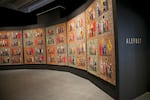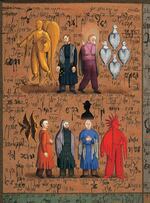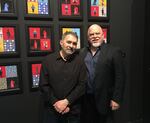
Grisha Bruskin's "Alefbet:The Alphabet of Memory" showcases his towering tapestries at the newly reopened Oregon Jewish Museum and Center for Holocaust Education.
Courtesy OJMCHE
This weekend is the big reopening for the Oregon Jewish Museum and Center for Holocaust Education.
Remember the space in Portland's South Park Blocks, where the dearly departed Museum of Contemporary Craft once lived? The space is now the new home of OJMCHE. The move doubles the museum's auditorium capacity, expands the archives collection and Holocaust education programs dramatically, and sets the stage for a bigger conversation about Jewish life, identity and community.
OJMCHE enlisted the help of former Portland Art Museum Chief Curator Bruce Guenther to help program its new space. His first choice is breathtaking. The inaugural fine art exhibit showcasing the work of Russian-American artist Grisha Bruskin.

A detail from "Alephbet" by Grisha Bruskin.
Courtesy of Grisha Bruskin
Bruskin, fresh off the opening of a show representing Russia at the Venice Biennale, has hung the walls of the museum with towering tapestries that fuse the ancient and the modern. “Alefbet: Alphabet of Memory” is the culmination of his many series incorporating culture and identity. The work unites folkloric Jewish characters drawn from Talmuddic and Kabbalic traditions, on huge, 15-foot tapestries. It’s hard not to lose yourself, standing in front of wall-sized works, taking in each of the 160 figures, their rich colors and detail, puzzling over the allegories. Don't skip the exhibit's table-sized interactive tablet, breaking down the histories and contexts of each vibrant figure.
As someone who grew up in a secular household, Bruskin says the works are very specific to his personal experience, as someone who had to labor toward a sense of identity. He joked with us about being teased as a young boy about being a Jew. But anti-Semitism in the former Soviet Union was not limited to a schoolyard matter. In his lifetime, it took the form of the repression of Hebrew schools, professional discrimination, and Stalinist-era assassinations of Jewish artists and intellectuals. A less repressive society, he says, would foster entirely different modes of expression.
"If I [were] born in the United States or Israel, I would never do this kind of art," Bruskin said. "It was possible only in Russia or Eastern Europe. I would not have a reason to do that."

Grisha Bruskin (left), and Bruce Guenther (right).
Palma Corral / Courtesy of Oregon Jewish Museum and Center for Holocaust Education
"The repression of Judaism in the Soviet Union and the life that valued art but disallowed content spurs a kind of invention, and certainly has driven this work to reality," Guenther said. "In the West, you'd be distracted by the disavowal of narrative and myth as a source in contemporary art."
Bruskin's woven masterpieces are not the museum's only radical change. Rather than focusing completely on Jewish experience, the permanent exhibition presents a broader view of constructed otherness in Oregon, from the mistreatment of Chinese immigrants to institutionalized discrimination against African-Americans. Museum director Judy Margles recently spoke with "Think Out Loud" host Dave Miller about the museum's new vision and their comprehensive exhibit on discrimination.
Grisha Bruskin’s “Alefbet” will be on view at the Oregon Jewish Museum and Center for Holocaust Education through October. The museum’s grand opening is Sunday, June 11.